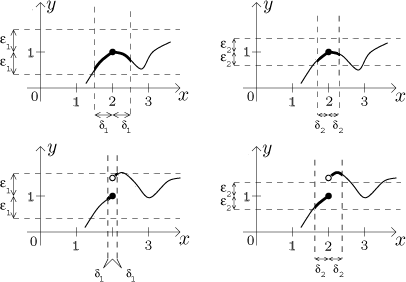
There are two basic ways to approach continuity. One is the approach we adopted here in Math Tutor, continuity is defined using the notion of limit. However, it is also possible to define continuity without the use of limit, which is "cleaner" from theoretical point of view. Therefore some more theoretically inclined mathematicians prefer this alternative approach and we will show it here, since there is a chance that some students will encounter it.
The definition goes as follows.
Definition.
Let f be a function defined on some neighborhood of a point a. We say that the function f is continuous at a if for everyε > 0 there existsδ > 0 such that for all x fromD( f ) satisfying|x − a| < δ we have| f (x) − f (a)| < ε.
Let's try to translate this into "normal language". This definition is
essentially a game (the popular "epsilon-delta" game), similar to the one we
considered when trying to understand the concept of a
limit. We are the ones
trying to show that the given function is continuous at a given point. Our
opponent is trying to spoil it for us. He gives us a tolerance
ε. Our task is to make sure
that the function does not move away from the value
Mathematically, somebody gives us the tolerance
ε. We have to find a
δ so that if we take any
x from the domain
Now recall two examples from the section on continuity.

How does the definition with with them? In the following picture we
tried to show two such games for each function. For two different epsilons we
tried to find the corresponding deltas, we always made the parts of the graph
that correspond to the choice of delta thicker. In the first example (the
first row of pictures) it seems that no matter what epsilon we are given,
even if it were incredibly small, we can still find a suitable delta so that
the corresponding part of the graph lies in the strip given by the tolerance
epsilon around the level

Note that both inequalities in the definition can be nicely written using
neighborhoods. The continuity condition then looks much neater, it goes like
this: For every
Similarly we define one-sided continuity, we just have to restrict those x to an appropriate side of a.
Definition.
Let f be a function defined on some left neighborhood of a point a. We say that the function f is continuous from the left at a if for everyε > 0 there existsδ > 0 such that for all x fromD( f ) satisfyinga − δ < x ≤ a we have| f (x) − f (a)| < ε.
Let f be a function defined on some right neighborhood of a point a. We say that the function f is continuous from the right at a if for everyε > 0 there existsδ > 0 such that for all x fromD( f ) satisfyinga ≤ x < a + δ we have| f (x) − f (a)| < ε.
The definition of continuity, especially its game nature, should have reminded you of the definition of a limit. In fact, it is almost exactly the same. The only difference in the mantra "for every... there is..." is that in the definition of the limit we did not allow x to be a, whereas here in the continuity case also the a is included in the game. From this one can deduce the following fact:
Theorem.
Consider a function f. This function is continuous at a from the left if and only if it has a limit at a from the left and this limit is equal tof (a).
Consider a function f. This function is continuous at a from the right if and only if it has a limit at a from the right and this limit is equal tof (a).
Consider a function f. This function is continuous at a if and only if it has a limit at a and this limit is equal tof (a).
This shows that the alternative definition of continuity defines the same notion as the definition from our section on continuity.
This theorem should seem quite natural. When we introduced continuity a while back, we said that it is really a question whether the graph of f goes to some specific point as x approaches a, and this formulation should have already rang some bells. If you now recall the meaning of limit and read again the introduction above, it should all seem perfectly clear.